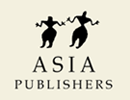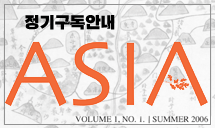|
Review of Asia: Magazine of Asian Literature
(Volume 1, No. 1) (Seoul: Asia Press, Summer 2006)
Theodore Hughes
(Department of East Asian Languages and Cultures, Columbia University)
The inaugural issue of Asia: Magazine of Asian Literature provides a space for a rethinking of Asia (as well as Afro-Asian connections) by writers and intellectuals stretching from Palestine and South Africa to Indonesia and Japan. It also occurs as part of the ongoing attempt in South Korea to extricate the Korean peninsula from the Cold War organization of borders (both epistemological and geographical) drawn in Asia under post-1945 U.S. hegemony.
As we see in Bang Hyun-seok’s formulation of “rainbow Asia” in the introduction to the issue, Asia is highly aware of the history of pan-Asianisms that inform Asian modernity and seeks to provide a forum for a non-essentialist, contingent array of exchanges that will move beyond colonialist and Cold War exploitations/orderings. The recovery of a progressive pan-Asianism, one opposed both to the Japanese militarist pan-Asianism of the 1930s and the U.S.-sponsored Cold War imagining of “Northeast Asia” also emerges in Kim Jae-yong’s discussion of Han Sŏr-ya’s participation in the 1956 Asian Writers Conference. Kim’s article points to the ways in which the invocation of the interrelatedness of Asia is linked both to the possibilities of an alternative twentieth century modernity and an openness to the progressive moments in the North Korean cultural and historical trajectory.
The extent of the complexity of pan-Asianisms and their historical effects comes to the fore when we remember that Japanese pan-Asianism informed the end of formal segregation in the U.S.—the wartime Japanese critique of U.S. racism, that is, helped to set the Civil Rights Movement in motion. The upshot of this movement, however, is contemporary U.S. multiculturalism, which shores up white hegemony by simultaneously eliding the economic register and essentializing people of color (who are racialized, forced to identify with “their culture”). Contemporary U.S. multiculturalism, in fact, is reminiscent of the Cultural Policy deployed by the Japanese Government-General in 1920s colonial Korea, just as the current U.S. militarism, as many have pointed out, calls to mind the expansionism of the 1930s Japanese wartime state. Here, we see the importance of Bang Hyun-seok’s noting of the dilemma South Korea finds itself in regarding Iraq—at once obliged to “send its troops to Iraq despite its most sympathetic understanding of the disastrous nature of the war….” The contradiction Bang points out can be read on a variety of levels; more than anything else, it calls for an assessment of the histories and affiliations of state formations within Asia. A cultural exchange which elides the reality of economic disparities/relations within Asia noted by Kim Chi-ha and differing, often contradictory affiliations with Western hegemonic powers may, in the end, rearticulate the borders it seeks to dismantle (in a way somewhat similar to U.S. multiculturalism’s shoring up of economic inequality and transcendental whiteness even as it claims to overcome social injustice and racial hierarchies).
In The Buru Quartet, Pramoedya Ananta Toer, the prominent Indonesian writer interviewed in Asia before his passing, portrays the ways in which Dutch colonialism produced hierarchized identities in Indonesia that characters in the novels often accept as natural. Pramoedya’s work is an archeology of the forms of knowledge produced in the colonial context, one that is at pains to show the historical contingency of human relations. Above all, Pramoedya is wary of the state, both the colonial apparatus and a resistance (individual or collective), that would mime its form in opposition. Pramoedya’s opening up of the past is also a concern with the present, one that intersects with the projects both of Kim Chi-ha, whose work appears in Asia, and Hwang Sŏk-yŏng, who figures prominently in the inaugural message. Kim’s emphasis on a “life community” combines with a “fusion of identities” that weaves its way through East and West, drawing from the historical past (for example, the Tonghak Movement, but also Western philosophy) to produce new kinds of human relations that disallow binary opposition. Hwang Sŏk-yŏng’s current location in Europe and his new literary project centering on diaspora and global flows of labor, in fact, can be linked to his own opening up of the past, his turn in The Guest (2001) to the Shamanic form to create a communal space to overcome the violence of the national division.
The overcoming of a history of violence and stasis enabled by the invoking of a plurality of voices in a text such as The Guest, I think, points to the kind of movement in textual space that Asia seeks to create, a movement, for example that allows us to encounter the portrayal of violence and ghosts as embodied memories in Bao Ninh’s The Sorrows of War. A bringing together of Bao Ninh and Hwang Sŏk-yŏng (here I am also thinking of Hwang’s 1980s The Shadow of Arms), that is, opens a space for a new kind of remembering of South Korea’s own history in Vietnam (a central concern of Bang Hyun-seok’s work). Readers in a U.S. cultural context still largely informed by the discourse of victimization deployed time and again to legitimize aggression—consider, for example, the Rambo films or the injunction to “Remember Pearl Harbor,” which actually signals the forgetting of Hawai’ian annexation—also stand to profit from this exchange.
|

 03/25
03/25 

















